|

The Bentley Boys are on the road again, this time taking
part on the 'Britain by Bentley Tour'. Thirty-one days
of magnificent driving, travelling some 3,000 miles
throughout England, Scotland and Wales. There are a
hundred participants from 13 different countries, celebrating
75 years of the Bentley Drivers Club.
Started our tour at the newly renovated Savoy Hotel
in London. Very nice, all the staff are 40 years or
younger (no sedate old butlers left!). The clients are
mostly 30-year-old Asians. At every step a staff member
approaches you, a bit too much service.The highlight
in London was a dinner at the Royal Automobile Club
– impressive entry hall with stairs leading up
to galleries which are decorated with vintage car racing
scenes. Downstairs a large swimming pool with Turkish
baths etc. The dining rooms are very elegant, everything
wood paneled, unchanged since the 1920s.
 |
| Click
for larger view |
 |
| |
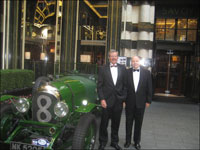
Kurt & Roger at the Savoy
in London with the 3-litre team car |
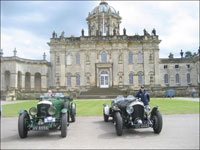
One of the many mansions we
visited |
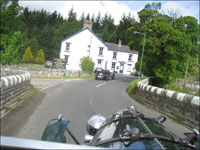
Scenic B roads |
| |
|
|
After two days of sightseeing in London,
we took the train to Bedford where we were met by our
"garagier" who took us to the Bentley and
we took off to our first stop in Lavenham. On the way
we met up with the group of 40, mostly vintage, Bentleys
at a firm where a BDC member hosted a lunch. The entertainment
was local dancing and a Tiger moth flying overhead.
The car needed a new battery, supplied by AA which has
special Bentley line. To our amazement they showed up
within an hour; so very good service.
The first rest day was spent in Lavenham, a well preserved
medieval town. We did join a guided tour and I had the
patience to follow for one hour and then disappeared
discreetly. In the evening we were joined by Sally and
Max our long time friends who live near by.
After two days of driving, and visiting many castles
including Sandringham and noble houses, we are now in
Yorkshire where Heather was born. I am writing this
note sipping a Starbucks after visiting the railroad
museum and the cathedral. As you can see this is a very
social and cultural trip! We usually depart by 8.30
am, stopping every two hours for a visit or a lunch
at the pub. The route selection takes us on B roads
and even single lane roads. The average speed is about
30 mph with all the roundabouts and stop lights in town.
So very relaxed but scenic driving. We arrive around
5pm, just in time to check over the car, get unpacked,
get ready for cocktails and dinner at 8pm. As we are
about the average age (mid-late 60s!), after dinner
at 10 everybody disappears, too tired for a drink at
the bar. The weather is typically English – sun,
rain and clouds, temperature between 12 and 18 degrees,
hot when the sun is out, cold in a windy rain.
We are having a good time meeting up with old friends
from all over the word and meeting some new faces.

Spent a free day in Edinburgh, Scotland's capital city,
taking an open-top bus tour to get an overview of the
city surrounded by water. The UNESCO World Heritage
Site at the heart of the city combines the medieval
Old Town and the Georgian New Town which, with its neo-classical
architecture, became known as "the Athens of the
North". The streets are steeped with history. Visited
the castle which sits on its own volcanic rock at the
top of the Royal Mile. The best view of Edinburgh is
from the castle ramparts as nothing in the city can
be higher. We then toured the war museum. Quite a few
of the older buildings are still covered in soot from
smoke from the many chimneys and look grey. Our tour
guide says things are brightening up a bit now, but
they cannot wash the old buildings as it would damage
the stone??
The morning sun woke us up at 5.30 am. – a good
start for our trip from Edinburgh to Loch Lomond. Crossed
the Forth bridge, 2.5 km long, the world's first major
steel bridge. Begun in 1883 and completed on 4th March
1890 when HRH Edward, Prince of Wales tapped into place
a "golden" rivet. Construction involved the
employment of 4,000 men at times. During operations
rescue boats were stationed under each cantilever, saving
at least 8 lives but still 57 lives were lost. The painting
of the bridge for years proved legendary. As soon as
the painters reach one end they would have to start
again at the other. Painting is now being done using
a state-of-the-art regime with at least a 20 year life
span. It was very impressive.
 |
| Click
for larger view |
 |
| |

Whiskey factory in Scotland |
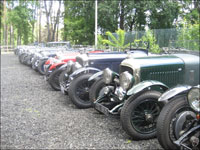
W.O. line up |
| |
|
Some of us stopped at the Gleneagles
Hotel for coffee, the world famous haunt for golfers.
Crossed the Tossachs National Park which separates the
Highlands from the Lowlands of Scotland. We decided
to take a 45-minute walk just outside Aberfeldy and
then stopped for a pint of shandy and a cigar in the
sun before proceeding to Loch Lomond. Loch Lomond is
the largest fresh water lake in Great Britain, lying
on the Highland Boundary Fault. It is a popular leisure
destination and of course well known for its "bonnie,
bonnie banks". Enjoyed a very entertaining evening
starting with a boat ride and champagne, followed by
dinner at the boat house. A Scottish piper presided
over the haggis (the Scottish version of a blood and
liver sausage) ritual. We retired about midnight after
good scotch.
The next day was a free day. We usually stay two nights
at one hotel, which reduces the number of times we have
to pack and unpack and allows us to do some quick washing.
Our free days seem to start wet, so our planned seaplane
flight was delayed for two hours. We eventually took
off and could enjoy a bird's eye view of the many lochs,
castles and golf courses. We later visited a local distillery,
further improving our taste buds for the single malt.
Ended the day with an informal dinner with some friends,
as usual a bottle too many but we slept well! We experienced
Scotland as very pleasant with beautiful scenery, a
bit too laid back in some areas, when waiting for service
at some hotels and restaurants one has to be a little
patient!
As to the cars, most seem to be running well. A Mark
Six Bentley needed new springs (hard to find on the
road) but luckily a garage in Edinburgh took some springs
from another car (with the understanding that they would
be eventually returned) thus allowing them to continue
on the tour. A modern Bentley had some typical electrical
problems, the car was towed some 60 miles to Glasgow
only to find out that a fuse had blown.
Left at 8 am next morning to cover some 240 miles through
Argyle Blue from loch to loch and over rolling hills
(they call them mountains here). The roadsides were
covered in moss and the rhododendrons in full bloom.
A magnificent ride for our last day in Scotland before
we headed back to England. Took a ferry across one of
the lochs allowing us take some more pictures. Stopped
in Gretna Green, the world's most popular lovers elopement
destination. Tonight we are staying in the Lake District,
very pretty with mountains surrounding the lakes, and
very, very green as it rains a lot here! We are near
Keswick at the Lahore Falls Hotel, an old fashioned
but comfortable establishment serving excellent food.
We have now completed 1000 miles and surprisingly only
had a couple of sprinkles while driving. The temperature
is around 18 centigrade which does require a leather
jacket and hat while driving, but warm enough to sit
in the sun in a tee shirt. The teamwork with Roger,
my co-driver, is still working well. We are driving
and navigating to perfection!. On a long day we need
some 60 liters of petrol, costing us over 100 pounds
or 150 dollars, but the car does not use any oil or
water!
Today another free day in the Lake district, light rain
start to with, the locals say more rain is coming in
and as I am typing these words the rain is getting much
heavier, I guess we are going to be grounded. There
is a local bus into town, we will probably venture out
with our rain gear on...

Left the beautiful lake district on a rainy
morning, put on all the rain gear to start with, then
it brightened up and got warmer as we drove further
south. Stopped at the Gibbon Bridge Hotel in Chipping
for lunch sponsored by a BDC (Bentley Drivers Club)
member. Another popular wedding destination with beautiful
gardens in the forest of Bowland. Quiet country roads
lead to many scattered, unspoilt villages and hamlets.
Drove on to Wales and stayed in Llandudno for two days.
Llandudno is Wales's largest seaside resort, boasting
two wonderful beaches. The town has kept its Victorian
and Edwardian elegance and splendour, despite its modern
attractions. The "Summit Complex" - hotel
and golf resort built in the 1900's - was requisitioned
in 1941 by the RAF and became a radar station during
the war. In 1952 Randolph Turpin, a champion middleweight
boxer, became the resident licensee until 1961 when
he got into trouble with the Inland Revenue. He ended
his life with a single bullet in 1966. At dinner the
Welsh Choir joined us with some 30 singers, the performance
started at 9 pm and lasted until 11 pm, with many of
the BDC members falling asleep!
 |
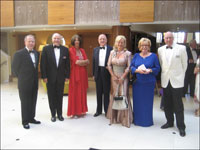 |
| Party
time |
Next morning Roger and I went to visit
the impressive Caenavon Castle some 30 miles away. Caenavon
castle is the most famous of Wales's castles and also
a World Heritage Site. Construction began in 1283 by
King Edward 1 as the definitive chapter in his conquest
of Wales. It was designed to echo the walls of Constantinople
and was not only a military stronghold but also a seat
of government and royal palace. In 1969 the castle was
the setting of the Investiture of Charles as Prince
of Wales. The castle also houses the Regimental Museum
of the Royal Welch Fusiliers - Wales's oldest regiment.
From there we took the Welsh Highland RR to Bedgellert;
the vintage wagons were pulled by steam engines which
were brought back from South Africa some 15 years ago.
The following day we drove from Wales to Crewe using
the motorway between Liverpool and Manchester. This
is one of the most densely populated areas in Europe
and the only way to make good time was to use the motorway,
something we try to avoid in a vintage open car!. Stopped
for lunch at another BDC members estate. Fortunately
the marquees did not have to be used as the sun was
out and we could relax in the wonderful gardens. We
spent the night at Crewe Hall, where we were treated
like royalty. The stately Jacobean mansion, located
on extensive grounds, dates back to 1615. It has one
of the most beautiful staircases in England, exquisite
marble fireplaces, ornate plaster work and carved wood.
It has its own chapel complete with stained glass windows.
We were served champagne again before dinner, sponsored
by Bentley Motors.
Next day we visited the Bentley factory in Crewe, one
of the highlights of the trip. Dress code was strictly
jacket and tie, so we drove our Bentleys with ties and
goggles! They still utilize the old brick stone factory
buildings from the 1930's, but the insides have been
modernized. They produce some 4000 cars per year here,
producing the flagship Mulsanne and the cheaper Continental
GT, with 4000 employees. Which means a lot of work is
still done by hand and the lines are moving very slowly,
giving the workers time to focus on quality and have
a chat in between. The factory has the capacity to double
and produce up to 10000 cars a year. We saw electronic
specialists, paint experts and cabinet makers, copper
smiths alongside trim specialists. 90 per cent of the
Mulsanne cars are personalized, i.e. you choose your
own colour, trim, wood inlays, family crest etc. Beautiful
cars for some three hundred thousand dollars. We spent
several interesting and happy hours here, fortunately
we were able to resist the temptation of placing a special
order!
We are still trying to keep fit which is getting harder
by the day as the food is generally very good and every
evening meal is started with drinks, then wine and finished
off with an after dinner drink.

After Crew we stayed in Buxton for two nights.
Buxton lies just outside the Peak District National
Park. It was founded by the Romans, who were attracted
to the site by the warm springs (constant temp of 28
degrees Centigrade) which emerge near the River Wye.
In the 18th - 19th centuries the spa attracted royalty
and gentry and over the years many magnificent buildings
were constructed and the town prospered. Limestone quarrying
became a major industry in the immediate area and, with
the advent of the railroad, stone was easily transported
across the country. Quarrying continues to be an important
industry still today. After the First World War the
spa industry went into gradual decline and by 1950 Buxton
was a backwater. Recovery began in 1980's with the reopening
of the Opera House and festivals and relocation of the
university of Derby.
 |
| Click
for larger view |
 |
| |
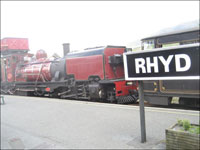
Welsh Highland RR |
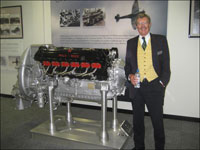
Visiting the Bentley factory
at Crewe |
| |
|
We then went on to visit Chatsworth
House, the magnificent estate of the Cavendish family
for 16 generations and where the Duke and Duchess of
Devonshire still reside. The original house was the
work of Sir Wm Cavendish in the mid 16th Century. He
was a crown commissioner responsible for dissolving
monasteries and his reward was a gift of land here.
The park covers some 400 hectares and is enclosed by
a nine mile long dry stone wall and deer fence. The
old hunting grounds are beautifully landscaped, ground
work being planned by Lancelot "Capability"
Brown in the mid 1700's. The house is filled with baroque
art, the ceilings painted with voluptuous scenes, the
walls decorated with paintings covering a period of
400 years. The current Duke collects contemporary art,
so in between the collections of old dutch masters and
Chinese porcelain one can enjoy modern sculptures; a
true treasure trove of modern and historic artifacts.
Over the years many famous people have stayed in Chatsworth,
including Mary Queen of Scots who was imprisoned here.
Another was Georgiana, Duchess of Devonshire who lived
here in a famous "menage a trois" in the late
18th Century. This visit allowed us to burn off some
calories as we walked the grounds and gardens extensively.
The next day started wet again and we drove to Ironbridge,
the birthplace of the Industrial Revolution some 300
years ago, where the first commercial foundry was constructed
and first cast iron bridge in England was built over
the river Severn in 1779. The town is now a World Heritage
site with a collection of well preserved brick buildings.
The weather improved gradually and we arrived in sunny
Stratford-upon-Avon where the forecast is warm and dry
for the next few days, i.e. 21 Centigrade, about 72
Fahrenheit with an occasional shower! (I have been advised
not to use the word "sprinkle" as it has a
different meaning in english!!}. Stratford is a town
small in size but large in history. Birthpace of William
Shakespeare, it is set on the banks of the river Avon.
Flowers abound everywhere and there are many parks and
green areas. There are still a large number of Tudor
styled thatched cottages - most famous being Anne Hathaway's,
a thatched farmhouse with stunning grounds and which
still contains many original items of the family. It
was here the young Shakespeare courted his future bride,
Anne. Being a favourite tourist destination, Stratford
has a rich programme of events and activities. In addition
to the Royal Shakespeare Theatre, which is celebrating
it's 50th birthday season, there is music in the park,
river racing and river cruising and always walks along
the river banks. Wonderful old pubs such as the Black
Swan (aka the Dirty Duck) and English cream teas (scones
with clotted cream and strawberry jam) served in the
afternoons. Our hotel is located on the river just a
few steps from everything so we don't need to use our
car.
 |
| Click
for larger view |
 |
| |
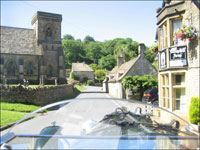
Early morning drive |

Lovely English village |
| |
|
The first day in Stratford we spent
walking around checking out all the important sites.
In the evening we drove to close by Royal Leamington
Spa to see family there. We had a quiet dinner with
Olaf & Caroline (sister-in-law taking care of some
much needed laundry for us) and at 9.30 we had to make
a quick exit as it was raining quite heavily. Put on
our rain gear (again) and drove back to Stratford on
slick roads, getting back to the hotel safely before
it got dark. Driving at night in the rain is no fun
as glasses, goggles and windscreen all get fogged up!
The rain stopped early in the morning, just as we were
getting ready for the Annual Concourse d'Elegance to
be held at the Bentley Club House in Wroxton. Some 350
Bentleys joined the event, quite a sight to behold!
We were able to meet up with some old friends from previous
tours and got a few laughs reliving car stories. The
morning was as usual cool and in the afternoon the expected
heat wave started allowing me to change into shorts
- finally! Tonight we have our second black tie event,
some 140 people will attend, tables of 12 - will see
what the noise level will be trying to shout across
the tables.

Drove through the lovely Cotswold's from Stratford to
Bath. The Cotswolds are without a doubt one of the prettiest
areas of England, well known for its gentle hillsides
("wolds"), river valleys, water meadows, beech
woods and dry stone walls. Ancient honey-coloured limestone
villages and historic market towns are scattered throughout
the countryside. Decided to skip the hotel breakfast
this Sunday morning. The sun was just starting to penetrate
the mist (it was like reading Brigadoon - with the Scottish
mist), no traffic and no noise. We drove through quiet
Chipping Campden and stopped for breakfast in the market
town of Broadway, where we could sit outside! By 11
am the crowds arrived and we sprinted on. I was navigating
and we took a wrong turn and ended up in Bourton-on-the-Water
(where we were supposed to be later in the day after
visiting Prescott). The town was absolutely packed with
people sitting on the lawn having picnics on this most
beautiful day. We enjoyed our pint of shandy and cigar
sitting on a river bank outside a pub. Parked the car
in front of the local Motor museum where Roger got nostalgic.
They had a 1937 Austin Clifton with a dickey seat (exterior
passenger seat located in the rear/boot), the same car
he owned some 35 years ago. Then went on to Prescott
where the Buggatis have their home, there has been top
flight motor racing here for almost 80 years. The famous
hill climb had very tight corners, not so good for the
Bentley, so we did not use the track but we watched
some cars racing up the hill in 42 seconds (world record
is 31 seconds). The smell of hot motor-oil, hot tarmac
and the sound of a well tuned engine, who could ask
for anything more?!. Motored on and eventually arrived
in Bath in the sweltering heat, one car had a broken
half shaft/rear axle, probably from the Prescott Hill
climb, while other car troubles included radiators,
brakes, magnetos etc. Most of the cars got fixed on
the free day in Bath.
 |
| Click
for larger view |
 |
| |
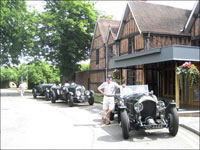
W.O.s in the Stratford
|
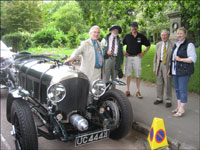
With Jenny Ford our tour organizer
and the Mayor of Bath |
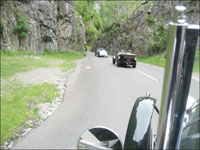
Driving through a gorge |
| |
|
|
The next day we spent in Bath and
were received by the mayor in the city park, followed
by a lunch in the County Club. The mayor, the President
of the County Club (a retired Air Marshall), the vicar
and the organist joined as well and they all gave speeches,
quite an affair! In the afternoon we took a guided tour
through this beautiful city. The Romans built a settlement
around the thermal springs here some 2000 years ago
and a vast complex of baths was constructed, defining
its spot in history. They are fuelled by mineral springs,
outputting over a million litres of hot water each day.
It was also a prosperous city during the medieval period,
the site of an Abbey and Cathedral, and during the Georgian
period the city was laid out with stately avenues, streets
and crescents, massive structures were built which still
exist today - extremely impressive. The nobles came
here in the 19th century to heal and relax with their
wives (or mistresses!). Beautiful parks and botanical
gardens were conceived for relaxation, today they are
ideal for picnics but local by-laws prevent the drinking
of alcohol outdoors, (however topless bathing, I was
told, is frowned upon but not illegal - get our priorities
right!). Jane Austin also knew Bath as a thriving spa
resort and lived here from 1801-1806; she set two of
her novels in Bath. During World War 2 the city suffered
a significant amount of damage during air raids. The
prestigious crescents and terraces were relatively unscathed
and later restored but large sections of more minor
Georgian and Victorian areas were demolished and replaced
by modern buildings, which now look out of place. The
town centre is mostly traffic free with lots of coffee
houses to sit outside, lots of young people roaming
around as Bath is also a University town. So we did
find the English summer after all - it lasted two days!
Our next stop was Torquay where the Atlantic ocean and
the English channel meet. Lost the starter motor. When
we arrived in the Hotel parking lot in Torquay I took
the starter motor out and saw that one of the bolts
holding the spring on the Bendix shaft in place was
sheared off. An Australian colleague had a spare set
and this was fitted with the help of our Belgium friends.
Two hours later the car was starting again with the
replacement unit. Collateral damage included minor burns
and a blue finger nail trying to refit the five pound
starter motor. The Australian colleague wants the spare
kit back, so I ordered a unit from my mechanic which
hopefully will arrive tomorrow. Then we have to replace
it again, by that time I will be an expert in replacing
starter motors. Luckily we were able to meet up with
great-niece Natasha and boyfriend Richard after worries
that we weren't going to make it in time.
Torquay lies on the "English Riviera", the
waterfront is the focus of life in the town with a lively
harbour and palm tree-lined promenade, giving it a Mediterranean
feel. From a background of pirates, smugglers and honest
fishermen, the town developed into a fashionable haven
for tourists. Beacon Quay, now a bustling tourist haunt,
was developed on the site of World War 2 slipways. Agatha
Christie enjoyed bathing at Beacon Cove which became
one of the original "ladies' beaches". And
an eccentric hotel proprietor was the inspiration for
John Cleese to create Basil Fawlty and Fawlty Towers
when he and the Python team stayed at a Torquay hotel.
We had very nice rooms overlooking the water. As today
is a free day we set out to find a quiet spot to enjoy
a lunch of english fish and chips. We landed in nearby
Dartmouth, set on the banks of the estuary of the river
Dart. It was of strategic importance as a deep water
port for sailing vessels. It was used as the sailing
point for the Crusades of 1147 and 1190 and was a home
of the Royal Navy during the reign of Edward the third
and was twice surprised and sacked during the 100 years'
war, after which the mouth of the estuary was closed
every night with a great chain. The pilgrim fathers
put into Dartmouth en-route from Southampton to America.
They rested a while before setting off on their journey
to America in the Mayflower and the Speedwell on 20
August 1620. About 300 miles west of Land's End they
realized the Speedwell was unseaworthy and returned
to Plymouth. The Mayflower departed alone to complete
the crossing to Cape Cod. In the latter days of World
War 2 the town was a base for American forces and one
of the departure points for Utah Beach in the D-day
landings.
We returned to our Torquay hotel for dinner, which was
a fun affair with magicians and card sharks entertaining
us. A very relaxed atmosphere which we thoroughly enjoyed
after a busy day of sight-seeing. Tomorrow we set out
for the New Forest and our next adventure...

Left Torquay for the New Forest. A busy day. Met up
with Richard (who came to visit us at the Imperial Hotel
with Natasha the night before) and a couple of his work
colleagues just outside Exeter. Took Richard for a spin
and he piloted the 6.5 litre easily through 1st, 2nd
and 3rd gear with 4th still a work in progress. Then
drove down the Devonshire coast and checked out all
the chisel beaches - sand the size of marbles! Every
where we stopped there were school children as the teachers
were on strike. Parents and non-striking teachers took
the kids out for a hands on cultural field trip. In
the evening we met up with Roger's friends from Switzerland
at Rhinefield House where we were staying, a beautiful
Gothic building set on 40 acres of gardens and woods
in the heart of the New Forest.
 |
| Click
for larger view |
 |
| |
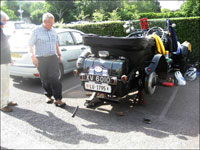
Half shaft repair in the parking
lot |

Fishing village, Dartmouth |
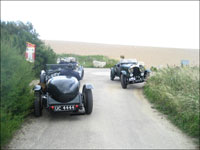
WO U-turn manouvers |
| |
|
|
The following day we went to see Lord
Montagu's world famous National Motor museum in Beaulieu.
The museum houses a collection of over 250 automobiles
and motor cycles telling the story of motoring on the
roads of Britain from the dawn of motoring to the present
day. Lord Montagu's father owned a Rolls Royce in 1908
and thought it would be nice to have a mascot that "belonged
to the Rolls Royce car as much as a carved wooden figurehead
belonged to a sailing vessel". In 1910, Claude
Johnson, the Managing Director of Rolls Royce, commissioned
Lord Montagu's friend, Charles Sykes (a sculptor), to
design the Flying Lady - the Spirit of Ecstasy. The
model for the flying lady was widely believed to be
Lord Montagu's mistress, Eleanor Thornton. The Spirit
of Ecstasy mascot has adorned the radiator of every
Rolls Royce since 1911. Eleanor never lived to witness
the global success of the emblem made in her image.
While travelling to India on the P & O liner SS
Persia with Lord Montagu in 1915, the ship was torpedoed
by a German U-boat. Eleanor lost her life but Lord Montagu
survived and returned to England. The secret love affair
was also immortalised in another mascot Sykes designed
for Lord Montagu. It was christened "The Whisper"
and depicts a young woman, believed to be Eleanor, in
fluttering robes with a secretive finger to her lips.
The New Forest is also home to ca. 3000 New Forest ponies
and foals that can be found wandering freely in the
Forest and surroundings (and in the middle of the roads!).
There have been ponies running wild here for hundreds
of years. Canute's Forest Law confirms their presence
as early as 1016. Although they may appear wild they
are in fact owned by the 400 or so "commoners"
who have ancient rights to allow animals to graze in
the forest. There have been many attempts to improve
on the breed. In the middle ages Henry the Third introduced
Welsh ponies to help strengthen the stock and Henry
the Eighth (not content at just his wives) had smaller
ponies killed. Queen Victoria lent the Forest her Arab
stallion.
Then went on to visit Buckler's Hard on the Beaulieu
river where warships for Nelson's Navy were built, three
of which took part in the Battle of Trafalgar. Some
2000 oak trees were required to build frigates so in
1800 the British government ordered a reforestation
programme to guarantee enough trees for future ship
building. However 100 years later steel was the material
of choice so the majestic oak trees remain standing
to this day. There can be few other places in England
where the ancient landscape has remained so unchanged
as here. In 1079 when William the Conqueror named the
area his "new hunting forest" little did he
know that nearly 1000 years later the "Nova Foresta"
would still remain much as it was, making this a unique
place. Another little tit bit of information, Alice
Liddell, Lewis Carroll's inspiration for Alice in Wonderland
is buried here. In the evening Abigail and Rob (newly
betrothed niece and soon to be nephew-in-law) joined
us for a BBQ dinner. We were slightly delayed as the
repair of the starter motor was a little more complex
than we expected...!
 |
| Click
for larger view |
 |
| |
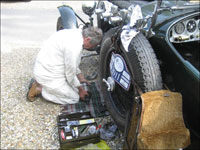
Starter motor repair |
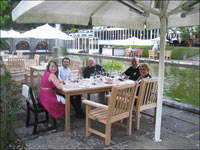
BBQ dinner in New Forest |

Jazz entertainement at Leeds
Castle |
| |
|
|
Push started the car for the run through
Sussex into Kent. The re installation of the starter
motor was not successful. With all the handling of the
unit it now has a loose connection in the housing. We
pushed on anyway to visit Winston Churchill's home at
Chartwell where we had a picnic lunch on the lawn. Then
drove to Maidstone - our last destination. Sat next
to Jimmy Medcalf for dinner, he did an apprenticeship
including (amongst other things) starter motors and
said it should not pose a big problem. He now owns the
most original Bentley team car from the 1920's. Next
morning we had an appointment with him at 9.30 am. He
immediately saw where the problem was - ripped the unit
apart and soldered the broken connection. It was my
duty to refit the unit onto the chassis, laying on my
back for the third time. One hour later we drove off
to Dover, under our own steam, to visit the white cliffs
of Dover and the Castle where one could easily see the
European continent.
The next morning, our last day with the group, we went
to see a BDC members automobile, clock and vintage musical
box collection, going down memory lane listening to
old songs. Drove back to our hotel and put on our tuxedos
for the final dinner at Leeds castle. The castle dates
back to 1119, although a manor house has stood on the
same site from the 9th century (at that time home of
the Saxon royal family). It is set on 2 islands on the
river Len and absolutely spectacular. Surrounded by
water in a beautiful setting and perfect weather we
sipped champagne and listened to a jazz band conducted
by a nephew of Glenn Miller. As it was 4th of July the
band dressed up in American uniforms. The final dinner
with lamb chops, speeches and gifts recognizing the
tour organizers wrapped up a very successful and enriching
tour.
Next morning it was time to say good bye. Roger took
off for Switzerland and I drove the car back to Bedford
for a complete service and storage.
This was a very well organized tour allowing us to meet
lots of new BDC members and seeing the best of Britain.
Cheerio and Happy Motoring!
|